Guitar lesson for beginners
The pentatonic, or pentatonic minor scale, or simply blues scale, is the basis of the majority of blues, rock and metal music of the 20th century. If you want to start playing lead guitar, improvising blues and rock, or writing classic sounding rock tunes, the pentatonic blues scale is definitely the place to start. But despite the name this isn’t only about blues. In fact getting this scale to sound like authentic blues is not actually that easy!
As the ‘pent’ prefix implies, this scale has just five notes, so is simpler than a typical major or minor scale (they have seven notes) – it’s basically a slimmed down minor scale, missing the 2nd and 6th notes. You can use it to solo in one key, or other typical twelve bar blues progressions. It really is an easy way to play a handful of notes that sound GREAT right from the get go.
Guitar lesson contents:
- The Pentatonic blues box
- Easy pentatonic licks
- Expanding the pentatonic box
- Practising the scale
- Beyond the pentatonic blues scale
In the key of E, the pentatonic blues scale is as follows:
The Pentatonic blues box
And this is how two octaves of the scale looks on the fretboard. Because of the shape of the fingering positions, this is sometimes referred to as a the Pentatonic box.
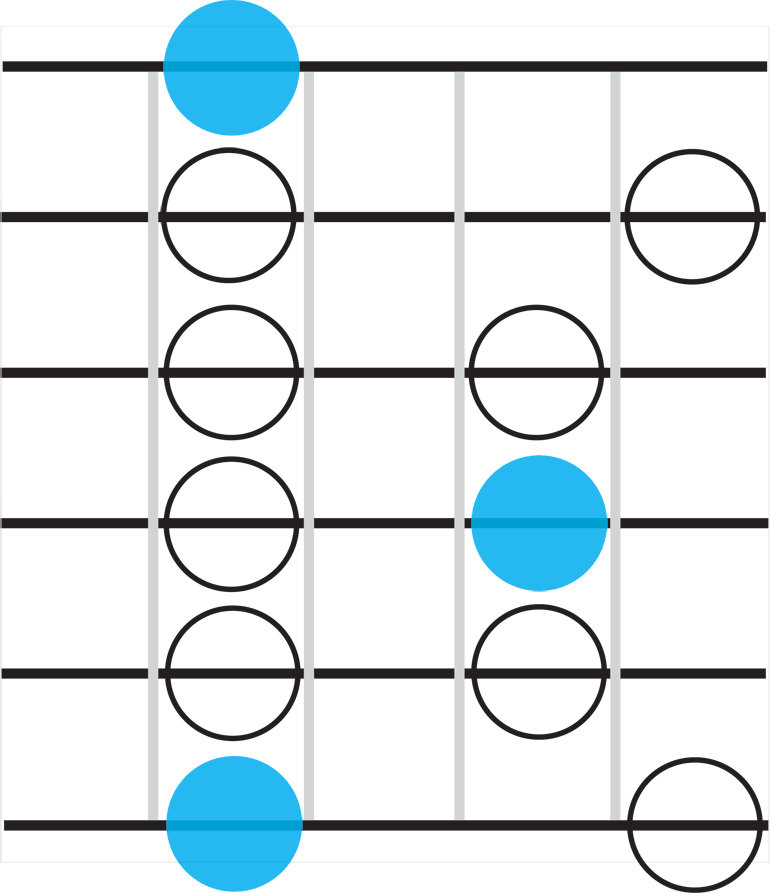
And this is how it sounds in A:
In the diagram above, the blue dots represent the root note. So if the lowest blue dot was at the 5th fret, we will be in A. The other blue dots will also be the A notes in this scale. Once you can remember this pattern, you can position it anywhere on the guitar neck and play in any key. To play in E, you will need to play at 0 or 12th fret.
So you can play any of these notes in any order and it should still sound great -it will help if you start or end on the root, but generally you can’t go wrong. Check out some of these really easy pentatonic examples, or jump forward to some that are more challenging.
Easy pentatonic licks
Here are a selection of easy licks to get you started – all are in the key of A, but the basic pattern can be moved to any key, up or down the neck. I’ve provided tab to easily find fingering positions, and audio clips to help you get it sounding right.
In the key of A, the pentatonic blues scale is as follows:
Lick 1: Easy blues riff
The first lick is really easy. This kind of riff was used by Muddy Waters in his famous track Mannish Boy, and it’s been used in countless other blues and rock records. It’s a great riff for call and response with a vocalist, and is exceptionally easy, using just three different notes.
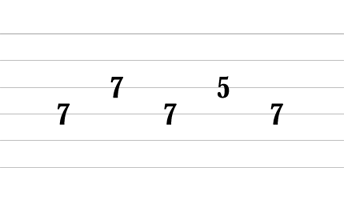
Lick 2: Easy rock riff
This second lick uses just four different notes, again really really simple, but very effective. I’ve played it with my palm of my picking hand muting the strings slightly. Sound familiar?

Lick 3: Another easy bluesy rock riff
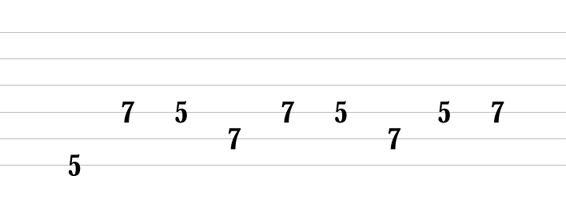
Lick 4: Using the whole box
This example uses more notes, but all are within the pentatonic box.

Expanding the pentatonic box
Obviously, the notes of any scale are repeated up and down the fretboard. Here is a slightly expanded version of the pentatonic blues box. Again, roots are colored blue.
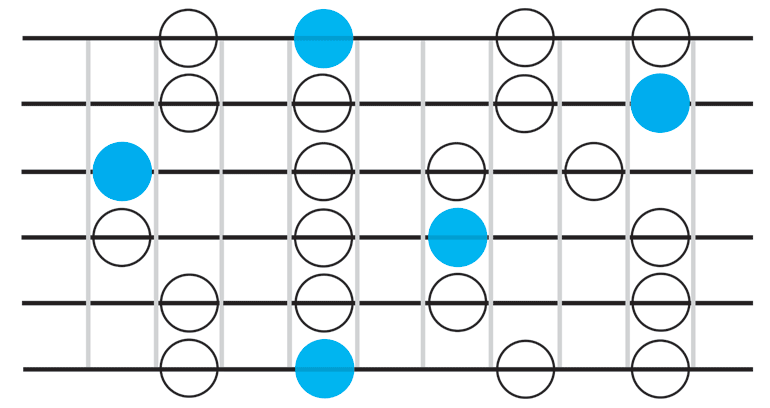
So, in the chart above we have expanded the pentatonic scale showing the positions on a larger are of fretboard. But why? Surely we had the notes already? Some people find it easier to remember scales in terms of box shape, others prefer thinking up and down the scale on a single string. There is no wrong or right way, just do what you find easiest. But there are occasions when either approach will be more appropriate – for example the single string scale is often more useful when sliding between notes. Ultimately you’ll use a combination of both approaches, without even thinking about it!
Try this next lick that uses the same pentatonic notes, but uses more of the fretboard to accomodate slides. If you are unfamiliar with the notation below, don’t worry – the diagonal lines simply mean a slide up, or down towards the note following it. It’s pretty slow here, but playing this kind of riff quickly is very much the basis of blues-rock soloing.
Lick 5: Beginning lead

Lick 6: Bringing it together
This final riff adds a short pentatonic intro to the riff used in lick 2 above. This lick only uses the pentatonic blues scale box. Note the hammer-offs in the first bar.
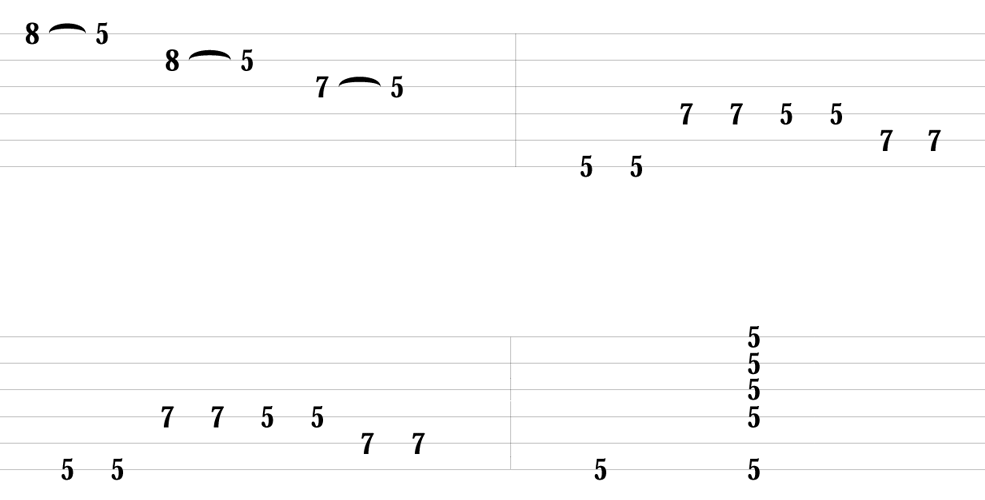
Practising the scale
You’re (hopefully) now able to play the above riffs. Try and commit the patterns to memory. Attempt to play them in different positions up and down the fretboard (i.e. in different keys). If you are struggling play them slowly. You can build up speed later.
Then try and make up your own. Start on a root at first, and see where you get to. Don’t feel you have to play too much. As shown above some of the most influential riffs of all time contain just a handful of notes.
Now, this is a good scale just for noodling with at home, but it really is worth jamming along with other players. I strongly advise getting hold of some pentatonic backing tracks and trying out some licks – you’ll be amazed at how great it can sound! Check out Nick Neblo’s Miscellaneous Backing Tracks Rock Blues Funk album, that has several different tempo blues and rock jam tracks, perfect for any guitarist wishing to get to grips with the pentatonic minor blues scale.
Going beyond the pentatonic box is also important. Ultimately you’ll want to be able to play anywhere on the guitar neck. The first thing is to learn where all the root notes are. You might not be able to memorize the scale in every key throughout the fretboard, but if you know where the root note is, it’s easy to apply (at least some of) the pattern. Tom Kolb’s Connecting Pentatonic Patterns is an excellent fretboard map to help learn the scale all over the fretboard, and very much worth having in your guitar reference library.
Beyond the pentatonic blues scale
As explained at the beginning of this lesson, the pentatonic scale is a minor scale with two notes (2nd and 6th) missing. Once you’ve got the pentatonic scale deeply engrained, you can try adding in those extra notes. Depending on where you place them, you will be playing the Dorian, Phrygian or Aeolian minor scales (or modes). You can throw in licks constructed from these scales at any time over a pentatonic backing track. These really do offer a great deal of color over and above the standard pentatonic scale. For further information on these modes, see understanding modes.
Summary
In this lesson we have learned:
- What the pentatonic blues minor scale is
- What the pentatonic box looks like
- How to play some simple pentatonic riffs
- How to think beyond the pentatonic box
I hope this lesson has been useful to you. Happy jamming!
